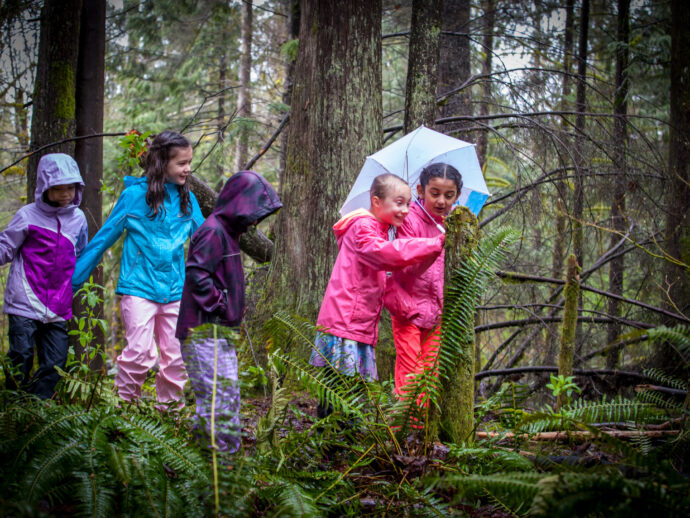
Outdoor Explorations, Forest Fridays, Wilderness Wednesdays … they’re all part of the new trend sweeping North America of giving children unstructured playtime in the great outdoors—and it’s got big benefits for all involved.
It’s a damp, dreary, rainy afternoon when I join the students of École Coquitlam River Elementary School (CRE) in BC for one of their regular Outdoor Explorations, but I seem to be the only one who notices.
Dressed from head to toe in colourful rain gear, the students inspect and collect rocks, pretend to fish in the nearby stream, play hide-and-seek behind trees, and generally explore the forest. Teachers and parent volunteers watch nearby, ready to act if needed, but otherwise the whole scene is a sort of happy, peaceful, unstructured chaos. The kids are free to be, well, kids.
Kids at play
Outdoor Explorations, Forest Fridays, Wilderness Wednesdays … they’re all essentially different names for the new trend sweeping North America of giving children unstructured playtime in the great outdoors. According to Sinead Joy, kindergarten French immersion teacher at CRE, “The main idea is that a class chooses a day and time to get outdoors and explore.”
Some of the time spent outside is instructional. “In the fall, we came to the forest while the salmon were spawning,” says Joy. “We watched as the salmon swam against the flow to find their spot to lay their eggs.”
However, much of the time spent outside is for free play. “Essentially, we head to the forest to give students the opportunity to play in the forest, learning skills like problem solving, conflict resolution, and risk taking.”
Lots of fun, plenty of benefits
The research is clear: outdoor education is great for all involved! According to recent research, spending time outdoors can help
- promote and improve physical activity
- counteract negative health concerns due to indoor sedentary living (such as obesity, type 2 diabetes, asthma, and vitamin D deficiency)
- improve concentration in children with ADHD
- reduce the risk of myopia (shortsightedness)
- encourage appropriate risk taking
- increase the odds of spending time outdoors as adults
Beyond the studies
Back at CRE, it’s not hard to see that the children adore their time in the forest. “It’s fun because you can explore all around you. You can see things that you haven’t seen before, like fish in the river and interesting bugs,” says eight-year-old Ayla Delver.
Joy agrees that the benefits are extensive. “We see the benefits of increased confidence, better social skills, improved language and communication, and better motivation and concentration,” she says.
“We have noticed an improvement in the students’ physical abilities, knowledge, and understanding in a real context, as well as the students’ active exploration and experimentation, creativity, and observation skills. While in the forest, many students find a sense of peace, while others find a sense of purpose.”
An outdoor education
Some schools have taken this idea further. Across Canada, several “forest schools” (also known as “outdoor schools” or “nature schools”) have sprouted up. Originating in Europe, the theory behind these schools is to use nature as a core part of the curriculum and an integrated part of the learning process.
According to Jasmine Green, a teacher at the Nature School at the Kortright Centre in Ontario, the unique learning environment “promotes a student-led philosophy where we educate the whole child. Students learn through exploration and interest. Teachers observe and record student interests and develop lessons and learning objectives around what inspires them, linking the Ontario Ministry of Education curriculum to provide a well-rounded education.”
Like the students at CRE, these children have a wonderful time exploring in nature—digging for worms, investigating animal tracks, building mud pies, and jumping in puddles. Although it may seem frivolous, this time outdoors has a big impact.
As Green explains, in addition to improved confidence, hazard perception, and communication, “watching them develop a positive relationship with nature has also been an incredible benefit, because if we want these young children to be stewards of the environment, we need to show them how incredible it is and allow them the opportunity to get to know it.”
One of the student’s parents adds: “Our sons come home from [outdoor education] days content, inspired, and tired in a way that I seldom see during other organized activities and traditional school days.
“We can tell that they’ve used their bodies and brains in a way that has encouraged physicality, courage, leadership, teamwork, and problem-solving skills. Most notably, they have had fun! And in play, the best sorts of learning take place naturally.”
A nature-inspired reading assignment
Here’s some homework for us adults. Pick up a copy of Your Brain on Nature (Collins, 2014) by Eva Selhub and Alan Logan to learn how being outdoors benefits all of us. The physician and biophilosopher duo discuss how nature can act as the ideal antidote to our fast-paced, technology-centric world, and offer ways to put the research into practice.

Risky business
Some parents and teachers may worry that playing outdoors is dangerous, but the research suggests otherwise.
“We need to recognize the difference between danger and risk. And we need to value long-term health and fun as much as we value safety,” states the Child & Nature Alliance of Canada’s Position Statement on Active Outdoor Play.
A certain amount of age-appropriate risk, such as getting dirty in the mud and climbing trees, is healthy and important for development. Skills gained from appropriate risk taking include confidence, resilience, and problem solving.



































